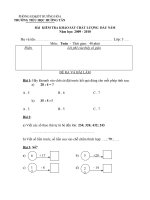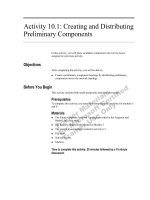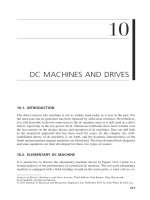R cam 10 t3 context and scope
Bạn đang xem bản rút gọn của tài liệu. Xem và tải ngay bản đầy đủ của tài liệu tại đây (2.45 MB, 4 trang )
PASSAGE
READING
1
Reading
You should spend about 20 minutes on Questions 1-13, which are based on
Passage 1 on the following pages.
Questions 1-4
Reading Passage 1 has five paragraphs, A-E.
Choose the correct heading for paragraphs B-E from the list of headings below.
Write the correct number, i-vii, in boxes 1-4 on your answer sheet.
List of Headings
Economic and social significance of tourism
i
ii
© The development of mass tourism
iii
Travel for the wealthy
iv
v___
Earning foreign exchange through tourism
Difficulty in recognising the economic effects of tourism
vi
The contribution of air travel to tourism
vii
The world impact of tourism
viii
The history of travel
=
Paragraph B
NH
Paragraph C
FW
Paragraph D
&
Example
Paragraph A
Paragraph E
Answer
viii
The Context, Meaning
and Scope of Tourism
Travel has existed since the beginning of time, when primitive man set out, often
traversing great distances in search of game, which provided the food and clothing
necessary for his survival. Throughout the course of history, people have travelled
for purposes of trade, religious conviction, economic gain, war, migration and other
equally compelling motivations. In the Roman era, wealthy aristocrats and high
government officials also travelled for pleasure. Seaside resorts located at Pompeii
and Herculaneum afforded citizens the opportunity to escape to their vacation villas
in order to avoid the summer heat of Rome. Travel, except during the Dark Ages,
has continued to grow and, throughout recorded history, has played a vital role in the
development of civilisations and their economies.
Tourism in the mass form as we know it today is a distinctly twentieth-century
phenomenon. Historians suggest that the advent of mass tourism began in England
during the industrial revolution with the rise of the middle class and the availability
of relatively inexpensive transportation. The creation of the commercial airline
industry following the Second World War and the subsequent development of the
jet aircraft in the 1950s signalled the rapid growth and expansion of international
travel. This growth led to the development of a major new industry: tourism. In turn,
international tourism became the concern of a number of world governments since
it not only provided new employment opportunities but also produced a means of
earning foreign exchange.
Tourism today has grown significantly in both economic and social importance. In
most industrialised countries over the past few years the fastest growth has been
seen in the area of services. One of the largest segments of the service industry,
although largely unrecognised as an entity in some of these countries, is travel
and tourism. According to the World Travel and Tourism Council (1992), ‘Travel
and tourism is the largest industry in the world on virtually any economic measure
including value-added capital investment, employment and tax contributions’. In
1992, the industry’s gross output was estimated to be $3.5 trillion, over 12 per cent
of all consumer spending. The travel and tourism industry is the world’s largest
employer with almost 130 million jobs, or almost 7 per cent of all employees. This
industry is the world’s leading industrial contributor, producing over 6 per cent of
the world’s gross national product and accounting for capital investment in excess
of $422 billion in direct, indirect and personal taxes each year. Thus, tourism has a
profound impact both on the world economy and, because of the educative effect of
travel and the effects on employment, on society itself.
However, the major problems of the travel and tourism industry that have hidden,
or obscured, its economic impact are the diversity and fragmentation of the
industry itself. The travel industry includes: hotels, motels and other types of
accommodation; restaurants and other food services; transportation services and
facilities; amusements, attractions and other leisure facilities; gift shops and a
large number of other enterprises. Since many of these businesses also serve
local residents, the impact of spending by visitors can easily be overlooked or
underestimated. In addition, Meis (1992) points out that the tourism industry
involves concepts that have remained amorphous to both analysts and decision
makers. Moreover, in all nations this problem has made it difficult for the industry
to develop any type of reliable or credible tourism information base in order to
estimate the contribution it makes to regional, national and global economies.
However, the nature of this very diversity makes travel and tourism ideal vehicles
for economic development in a wide variety of countries, regions or communities.
Once the exclusive province of the wealthy, travel and tourism have become an
institutionalised way of life for most of the population. In fact, McIntosh and
Goeldner (1990) suggest that tourism has become the largest commodity in
international trade for many nations and, for a significant number of other countries,
it ranks second or third. For example, tourism is the major source of income in
Bermuda, Greece, Italy, Spain, Switzerland and most Caribbean countries. In
addition, Hawkins and Ritchie, quoting from data published by the American
Express Company, suggest that the travel and tourism industry is the number
one ranked employer in the Bahamas, Brazil, Canada, France, (the former) West
Germany, Hong Kong. Italy. Jamaica, Japan, Singapore, the United Kingdom and
the United States. However, because of problems of definition, which directly affect
statistical measurement, it is not possible with any degree of certainty to provide
precise, valid or reliable data about the extent of world-wide tourism participation
or its economic impact. In many cases, similar difficulties arise when attempts are
made to measure domestic tourism.
Questions 5-10
Do the following statements agree with the information given in Reading Passage 1?
In boxes 5-10 on your answer sheet, write
TRUE
FALSE
NOT GIVEN _
if the statement agrees with the information
if the statement contradicts the information
if there is no information on this
5
The largest employment figures in the world are found in the travel and tourism
industry.
6
Tourism contributes over six per cent of the Australian gross national product.
Tourism has a social impact because it promotes recreation.
Two main features of the travel and tourism industry make its economic significance
difficult to ascertain.
9
Visitor spending is always greater than the spending of residents in tourist areas.
10
Itis easy to show statistically how tourism affects individual economies.
Questions 11-13
Complete the sentences below.
Choose NO MORE THAN THREE WORDS from the passage for each answer.
Write your answers in boxes 11—13 on your answer sheet.
11
In Greece, tourism is the most important.................... ‘
12
The travel and tourism industry in Jamaica is the major................... :
13
The problems associated with measuring international tourism are often reflected in
the measurement of..................... :









